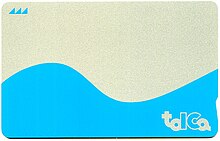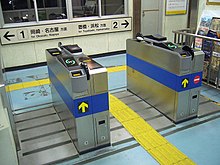TOICA
- Machine translation, like DeepL or Google Translate, is a useful starting point for translations, but translators must revise errors as necessary and confirm that the translation is accurate, rather than simply copy-pasting machine-translated text into the English Wikipedia.
- Consider adding a topic to this template: there are already 3,676 articles in the main category, and specifying
|topic=will aid in categorization. - Do not translate text that appears unreliable or low-quality. If possible, verify the text with references provided in the foreign-language article.
- You must provide copyright attribution in the edit summary accompanying your translation by providing an interlanguage link to the source of your translation. A model attribution edit summary is
Content in this edit is translated from the existing Japanese Wikipedia article at [[:ja:TOICA]]; see its history for attribution. - You may also add the template
{{Translated|ja|TOICA}}to the talk page. - For more guidance, see Wikipedia:Translation.
- FeliCa
- JR Central stations
TOICA (トイカ, Toika) is a rechargeable contactless smart card ticketing system for JR Central railway network which was introduced in the Chūkyō Area (Greater Nagoya) of Japan on November 25, 2006. The name is an acronym for Tōkai IC Card.[2] Like JR East's Suica or JR West's ICOCA, the card uses RFID technology developed by Sony known as FeliCa.[3][4]

A year after launch, in December 2007, 350,000 cards had been issued. By Spring 2023, 3.27 million cards had been issued. In the Nagoya area, 50% of riders (and 70% of commuter pass holders) use the card.[5]
Since 2013, it has been part of Japan's Nationwide Mutual Usage Service, allowing it to be used in major cities across the country.[6]
Usable area

As of 2022, TOICA is currently accepted on JR Central lines in the following area:
- Tōkaidō Main Line, between Atami and Maibara (the whole line of JR Central operation)
- Includes branch between Ōgaki and Mino-Akasaka
- East of Atami and west of Maibara, stations are served by Suica or ICOCA, see below on limitations when using
- Gotemba Line, between Kōzu and Numazu (the whole line)
- East of Kōzu, stations are served by Suica
- Minobu Line, between Fuji and Nishi-Fujinomiya
- Iida Line, between Toyohashi and Toyokawa
- Taketoyo Line, between Ōbu and Taketoyo (the whole line)
- Chūō Main Line, between Nagoya and Nakatsugawa
- Kansai Main Line, between Nagoya and Kameyama (the whole line of JR Central operation)
- West of Kameyama, stations are served by ICOCA
- Takayama Main Line, between Gifu and Mino-Ōta
- Taita Line, between Mino-Ōta and Tajimi (the whole line)
Since 2018, TOICA is also supported on the Aichi Loop Line (Aikan).
Interoperation

As of March 23, 2013, TOICA began interoperability with nine other major IC cards, allowing it to be used country-wide as part of Japan's Nationwide Mutual Usage Service.[7] As such, it may be used interchangeably with manaca, Suica (including Mobile Suica), PASMO, ICOCA, SUGOCA, and other cards.
Prior to the beginning of nationwide interoperability, TOICA became interoperable with Suica and ICOCA in March 2008 and with SUGOCA in March 2011.
Smart card systems in Shizuoka Prefecture, namely LuLuCa (Shizuoka Railway) and NicePass (Enshu Railway), are yet to be integrated.
References
- ^ "よくいただくご質問". Central Japan Railway Company (in Japanese). Retrieved April 10, 2024.
- ^ JR Bulletin 057. JR Central. Accessed December 5, 2007.
- ^ "Japan's prepaid transportation cards – IC cards – Japan Station". www.japanstation.com. Retrieved January 13, 2021.
- ^ "ソニー株式会社 | FeliCa | 個人のお客様 | アプリ・ソフトウェア | SFCard Viewer 2". Sony (in Japanese). Retrieved February 26, 2024.
- ^ Japanese Wikipedia article of TOICA, retrieved on April 3, 2008.
- ^ Ito, Etsuro (October 2013). "Launch of Nationwide Interoperable Transport System IC Cards" (PDF). East Japan Railway Culture Foundation. Japan Railway & Transport Review. pp. 6–15. Retrieved March 7, 2024.
- ^ "Prepaid IC Cards in Japan". Retrieved May 15, 2013.
External links
- (in Japanese) Official website by JR Central
- v
- t
- e
| Mutual Usage | |
|---|---|
| Other cards |
|











































